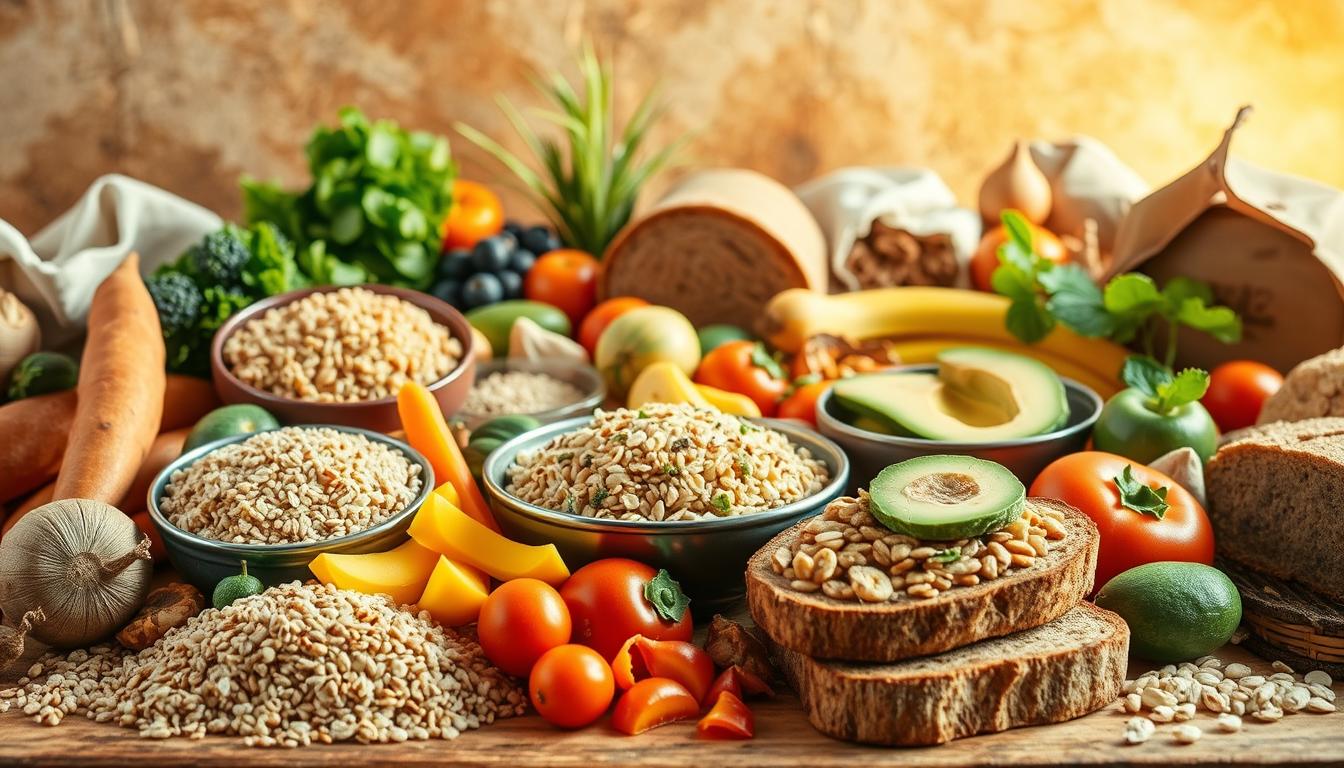10 High Carb Foods That Are Incredibly Healthy
For years, carbohydrates have been unfairly blamed for weight gain and health issues. But not all carbs are created equal. Nutrient-dense, fiber-rich options play a vital role in energy production, gut health, and overall wellness when chosen wisely.
Many people avoid carbs completely, fearing they’ll derail their diet. However, whole food sources like fruits, legumes, and whole grains offer essential vitamins and minerals. These foods fuel your body efficiently while supporting long-term health goals.
This guide highlights ten delicious options that prove carbs belong in balanced eating plans. You’ll learn how these choices differ from processed snacks and refined sugars. Discover practical ways to enjoy them while meeting nutritional needs and maintaining energy levels throughout the day.
Key Takeaways
- Not all carbohydrates negatively impact health – quality matters most
- Whole-food sources provide fiber, vitamins, and sustained energy
- Smart carb choices can support digestion and metabolic health
- Balance is key when incorporating these foods into meals
- Processed carbs differ significantly from nutrient-rich options
Understanding the Role of Carbohydrates in Your Diet
Fueling daily activities and complex biological processes, carbohydrates remain indispensable in human nutrition. These macronutrients break down into three forms: sugars for instant energy, starches for gradual fuel release, and fiber for digestive support. Each type serves unique purposes that keep your body functioning optimally.
Adults typically need 60-130 grams daily, depending on activity levels and health goals. Active individuals often require more to maintain energy stores, while others may thrive at lower intakes. The key lies in choosing quality sources like fruits and whole grains over processed snacks.
| Type | Primary Function | Common Sources |
|---|---|---|
| Sugars | Quick energy bursts | Fruit, milk |
| Starches | Sustained energy | Potatoes, oats |
| Fiber | Digestive health | Beans, vegetables |
Fiber-rich options do more than aid digestion—they help stabilize blood sugar and keep hunger at bay. This makes them valuable for weight management and metabolic health. Always pair carb choices with proteins or healthy fats for balanced meals.
Remember: nutrient-packed sources deliver vitamins and minerals alongside energy. A sweet potato offers beta-carotene, while quinoa provides complete protein. Smart selections turn carbohydrates into powerful allies for overall wellness.
What Makes “High Carb Foods That Are Incredibly Healthy” Stand Out?
Carbohydrates often face unnecessary criticism in nutrition conversations. The key difference lies in how these nutrients are packaged. Whole, minimally processed options deliver energy alongside essential compounds that refined versions lack.
Myth Busting About Carbohydrates
Many believe all carbs cause weight gain or blood sugar spikes. This misconception ignores crucial distinctions:
- Processed options (like white bread) lose fiber and nutrients during refining
- Whole-food sources retain natural fiber, vitamins, and protective plant compounds
- Studies show populations eating quality carbs have lower diabetes and heart disease rates
The Science Behind Carb Benefits
Nutrient-rich carbohydrates work like multitasking fuel. Oats contain beta-glucan fiber that supports heart health, while berries pack antioxidants that combat cellular stress. These foods also:
- Release energy gradually due to fiber content
- Provide B vitamins for metabolism support
- Deliver minerals like magnesium for nerve function
Research confirms that choosing wisely matters more than avoiding carbs entirely. A Journal of Nutrition study found people consuming whole grains had 20% lower inflammation markers than refined grain eaters.
Nutritional Overview of Complex Carbohydrates

Navigating the world of carbohydrates can feel confusing, but complex carbs simplify the choice with science-backed benefits. These multi-chain molecules take longer to break down, delivering steady energy instead of sudden spikes. Whole grains, lentils, and squash shine as prime examples of this nutrient-packed category.
Structural differences between carb types matter. Simple sugars rush through digestion, while complex varieties work like timed-release fuel capsules. This slow processing helps maintain balanced blood sugar levels, crucial for avoiding midday energy crashes.
| Type | Key Features | Examples |
|---|---|---|
| Complex Carbs | 3+ sugar chains, high fiber | Brown rice, black beans |
| Simple Carbs | 1-2 sugar chains, low fiber | Table sugar, syrups |
Fiber acts as complex carbs’ secret weapon. A single cup of lentils provides 15 grams – half your daily needs. This roughage feeds gut bacteria and slows glucose absorption, creating dual benefits for digestion and metabolic health.
Portion control remains key. Most adults thrive with 45-60 grams per meal, adjusted for activity levels. Pairing these carbs with proteins like chicken or tofu creates meals that sustain energy for hours.
Beyond fuel, complex sources deliver essential nutrients often missing in modern diets. Quinoa offers complete protein, while sweet potatoes supply eye-protecting vitamin A. Smart choices turn carbs into allies for long-term wellness.
Whole Grains for Sustained Energy

Whole grains power through myths with science-backed benefits. Unlike refined counterparts, they retain bran and germ layers packed with nutrients. This natural packaging delivers lasting fuel while supporting metabolic health.
Quinoa: A Complete Protein Source
This ancient grain stands apart with all nine essential amino acids. One cup cooked provides 40 grams of carbs alongside 8 grams of protein. Its magnesium content helps regulate blood pressure, while fiber promotes steady digestion.
Oats: Rich in Fiber and Beta-Glucan
A breakfast bowl delivers 54 grams of complex carbs per raw cup. The standout ingredient? Beta-glucan fiber forms gel-like substances that trap cholesterol. Studies show regular oat consumption can lower LDL levels by 5-7%.
Buckwheat: A Gluten-Free Pseudocereal
Despite its name, this triangular seed outperforms traditional grains. Cooked groats offer 20 grams of carbs per 100-gram serving. Rich in rutin antioxidants, it supports blood vessel health and reduces inflammation markers.
These options prove that smart carb choices fuel both body and brain. Pair them with vegetables or lean proteins for meals that keep energy levels stable for hours.
Root Vegetables That Pack a Nutritional Punch

Beneath the soil lies nature’s treasure trove of energy-rich foods. Root vegetables combine earthy flavors with impressive nutrient profiles, delivering both sustenance and health benefits in every bite.
Sweet Potatoes: Vitamin A and Antioxidants
These orange-hued gems contain 20.7 grams of carbohydrates per half-cup serving. Their vibrant color signals high beta-carotene levels – a compound your body converts to vitamin A for sharp vision and immune support.
Beyond eye health, sweet potatoes deliver vitamin C and potassium. Their natural antioxidants combat oxidative stress, potentially lowering chronic disease risks. Roast them whole or mash for a fiber-rich side dish.
Beets: Nitrates for Heart Health
With 10 grams of carbs per 100-gram portion, these ruby roots excel at cardiovascular support. Their nitrates convert to nitric oxide – a compound that relaxes blood vessels and improves circulation.
Studies show beet consumption may enhance athletic performance by 5% through better oxygen use. Grate raw beets into salads or roast them to caramelize natural sugars while preserving nutrients.
Fruit Options: Boosting Vitamins and Fiber

Nature’s sweetest offerings double as nutritional powerhouses. These colorful choices deliver essential vitamins and fiber alongside natural sugars. Their unique combinations support everything from immune function to digestive wellness.
Bananas: Energy and Potassium
Bananas pack 31 grams of carbs in a large fruit, making them ideal for quick energy replenishment. Their potassium content – higher than most snacks – helps regulate blood pressure and muscle function.
Research shows the vitamin B6 in bananas supports neurotransmitter production. “Eating one before workouts provides sustained fuel without digestive discomfort,” notes a sports nutrition study.
Oranges: Vitamin C and Hydration
With 15.5 grams of carbs per 100-gram serving, oranges balance sweetness with hydration. Their vitamin C levels surpass daily requirements, boosting collagen synthesis and immune defenses.
The fruit’s high water content and fiber create lasting satiety. Studies link regular consumption to improved heart health and reduced kidney stone risk.
Apples: Fiber and Phytochemicals
Apples offer 14-16g of carbs alongside soluble fiber called pectin. This nutrient slows sugar absorption, promoting stable blood glucose levels.
Antioxidants like quercetin concentrate in the skin, providing anti-inflammatory benefits. Leaving the peel intact maximizes these protective compounds.
Legumes and Plant-Based Proteins for a Balanced Diet

Plant-powered plates thrive when legumes take center stage. These edible seeds combine slow-burning carbohydrates with muscle-supporting proteins, creating meals that satisfy hunger and nourish cells. Their unique nutrient profiles make them indispensable for modern diets seeking both sustainability and wellness.
Chickpeas: Fiber and Protein
One hundred grams of chickpeas delivers 27.4 grams of energizing carbs alongside nearly 8 grams of fiber. This legume shines as a good source of plant-based protein, offering 7 grams per serving. Its iron content supports oxygen transport, while B vitamins aid energy metabolism.
Versatility defines chickpeas. Blend them into hummus, roast for crunchy snacks, or toss into salads. Their balanced macronutrient profile helps stabilize blood sugar, making them ideal for sustained afternoon energy.
Kidney Beans: Nutrient-Rich Energy
These ruby-red beans pack 21.5 grams of carbs per 100-gram portion, primarily from digestion-friendly starches. As a minerals powerhouse, they provide 20% of daily iron needs and 17% of magnesium requirements. Antioxidant compounds like anthocyanins combat cellular stress linked to chronic diseases.
Regular consumption supports heart health and muscle maintenance. Add them to chili, soups, or grain bowls for meals that keep you full for hours. Their fiber-protein combo makes them particularly valuable in plant-focused diets.
Ancient and Unique Grains to Diversify Your Plate
History’s forgotten grains are making a comeback in modern kitchens. These nutrient-dense options offer unique textures and flavors while delivering essential nutrients often missing from refined staples. Their revival brings diversity to meals and boosts nutritional value effortlessly.
Amaranth: Mineral-Rich and Gluten-Free
This tiny seed packs a punch with 9 grams of protein per cooked cup – rare among plant sources. Its mineral content shines, providing 40% of daily manganese needs and 30% of magnesium requirements. These nutrients support bone health and energy production.
Amaranth contains all essential amino acids, making it a complete protein source. Its gluten-free nature suits various diets, while the mild nutty flavor enhances porridge or salads. Try popping the seeds like miniature popcorn for a crunchy snack.
These ancient grains prove that culinary traditions hold timeless wisdom. Incorporating them adds sustained energy and vital nutrients to contemporary eating patterns without sacrificing taste or versatility.



